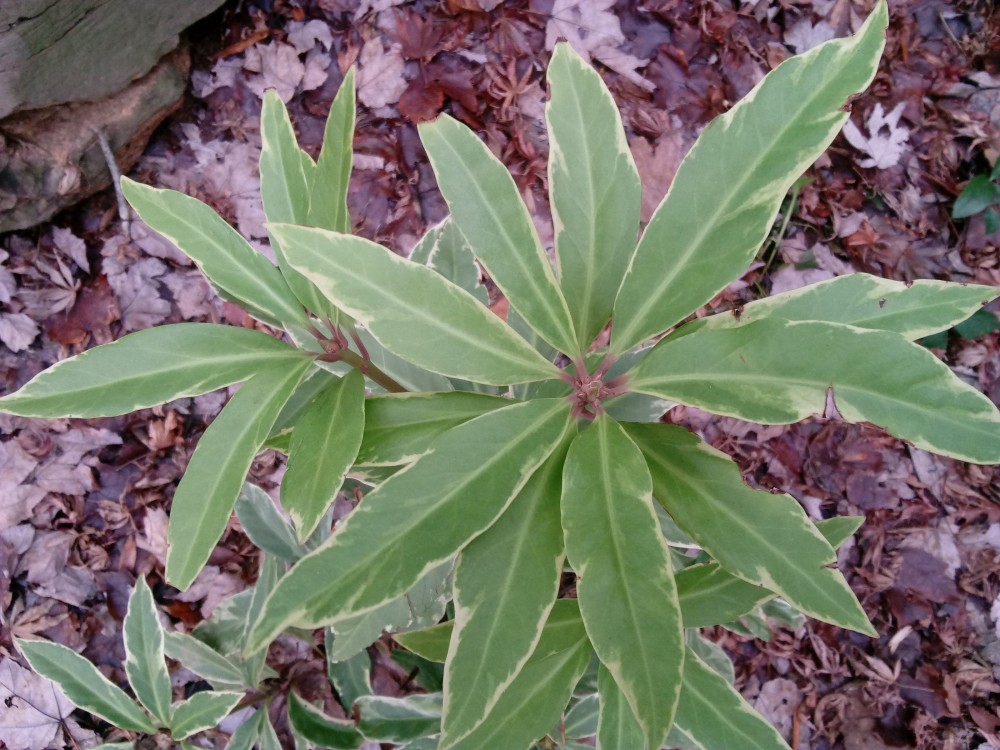I debate taking actions to protect marginally cold hardy evergreens planted this year. The overriding philosophy of this garden has long been “survival of the fittest”, and without a doubt, constructing leaf filled cages to insulate fatsias and Anise shrubs (Illicium floridanum ‘Pink Frost’, below) is contrary to three decades of trial and error in determining plants sturdy enough to survive with a bare minimum of the gardener’s intervention.
I suspect that Anise shrub , and certainly fatsia (Fatsia japonica ‘Spider’s Web’, below), are over promised as cold hardy to zone 7. Of course, I could do nothing, depend on references that state they’re cold hardy, and see what happens. In recent years I’ve verified, at least to my satisfaction, that gardenias rated as zone 6 cold hardy, are not, and should hardly be considered as hardy to zone 7 (zero degrees Fahrenheit) . But, this required allowing the gardenias to overwinter, and perish, without protection. What is an “I told you so” worth?
A Japanese anise shrub (Illicium anisatum ‘Murasaki-no-sato’ Purple Glaze, below) survived several years in the garden until being overwhelmed by more vigorous neighbors. The cold didn’t kill it, but a lot of energy was expended recovering each spring. Probably, this shrub would have more vigor one hardiness zone to the south, and I expect a similar result from the southeastern U.S. native.
Both Anise shrub and the fatsia have variegated foliage, which typically diminishes vigor and further limits cold hardiness, and new plantings are more vulnerable to cold until roots are well established. So, it is a bit unreasonable to expect these marginally cold hardy shrubs to survive their first winter in the garden without assistance.
So, constructing leaf filled cages is probably a good bet, at least in this first year after planting. No purpose is served by leaving the fatsias and Anise shrubs to go unprotected, and certainly there are plenty of leaves covering the garden to fill the cages. Whether this will be enough to get them through the winter, we’ll find out.
With leaf filled cages, if it rains a lot, it doesn’t rot the plants? Are there other things one can do to push the microclimate slightly warmer? (from 7 to 7b?)
Some folks spray foliage with antidessicants, but I suspect this is most effective with newly planted broadleaf evergreensn, that are cold hardy to the region, and not when you are trying to stretch a zone. I will fill cages with unshredded leaves so there is more air and less damage to foliage and branches from wet leaves. I haven’t done this before, but I know it’s fairly standard practice.
I’ll have try this with my aspidistra cast iron plants. They are now starting to recover from last winter. Another cold winter will probably kill them.
The advantage of the basket of leaves is that it insulates both roots and stems. It seems that the wider and taller the cage, the better for insulation.
Dave
Agree with all all your comments about gardens needing to be independent.
However, what could possibly compare to the mind altering experience of inhaling the fragrance of a gardenia flower?
I have also tried growing the so-called cold hardy gardenias in my North Carolina zone 7 micro climatevgarden to no avail. So did not try again here in my new Va garden.
I left behind large flowering gardenia bushes in my Florida garden when I moved to North Carolina and missed them so much that I thought I would try.
Florida is really the best place for them to grow, as long as they are on nematode resistant root stock.
The lessons we learn from our garden eh?
Thanks,
The English gardener.
I recall that a gardenia or two made it for a year or two with winters that didn’t drop below zero. One year our low was about seven or eight above, but the next winter dropped a few degrees below zero, and the next to six or seven below. Even when the few gardenias survived there were no more than a flower or two as they struggled.